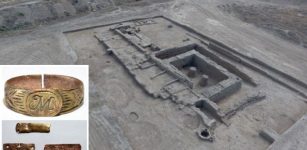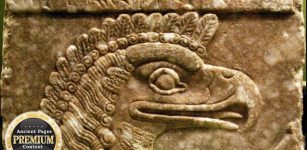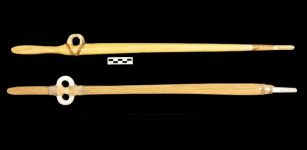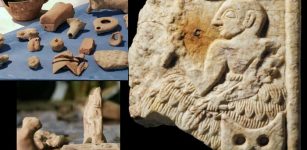Hagar Qim: “Standing/Worshipping Stones” – Megalithic Complex In Malta Dated To 3600 – 3200 BC
A. Sutherland - AncientPages.com - The Neolithic cultures of Malta left a legacy of some of the most magnificent temples. It is believed that ancient Malta's natural surroundings deeply inspired the building traditions of its people.
Hagar Qim - Model. National Museum of Archaeology. Image credit: Enrique Íñiguez Rodríguez (Qoan) - CC BY-SA 4.0
Ancient builders used limestone as a primary material for their creations because the country that covers over 300 square kilometers (including the outlying islands of Gozo and Comino) is basically composed of this material.
They created many megalithic temples and expressed their religious beliefs through these mighty structures. One such temple is Hagar Qim, located on the south coast of the island of Malta. It is one of the most massive megaliths and one of the best preserved.
Most temples of Malta face towards the southeast, which would have meant warmth and sunlight all year round. In the case of Hagar Qim (Haġar Qim, Qrendi), for example, evidence for the alignment with the equinoxes and solstices has been discovered by archaeologists.
Hagar Qim ruins, Malta. Image credit: jkb- CC BY-SA 3.0
It means that the calendar was of great importance to these ancient people. In one of the chambers (apses) of the main temple, there is a hole through which the rays of the rising sun fall on the summer solstice day.
Not much is known about this structure. The temple of Hagar Qim was excavated for the first time in 1839 and dated back to c. 3600 – 3200 BC. It stands on a hilltop overlooking the sea and the islet of Filfla.
Figurines Of Fat Female Bodies
During the restoration work in 1949 at Hagar Qim, four small figurines of fat women's bodies were found in this temple – now on display in the National Museum of Archaeology, Valletta.
Similar figurines were also found in several other places across Malta. This idol is believed to represent the Mother Goddess. Excavations also revealed certain features possibly associated with fertility rituals, such as statues (sculptures) with solar alignments and a megalith considered phallic. An altar with a concave top was probably used for animal sacrifices, as the animal bones were unearthed, while the screened doorways at the Hagar Qim complex may indicate possible use by oracles.
No burials exist in the temple or the area surrounding Hagar Qim, nor have any human bones been discovered in Maltese temples.
Maltese temple statuary. Figurines from Ħaġar Qim, National Museum of Archaeology of Malta. Image credit: Hamelin de Guettelet - CC BY-SA 3.0
All what is today known about the mysterious Hagar Qim site, is based on archaeological evidence and other observations made by the early excavators of the megalithic sites of Malta. It is known that
"the temples replicate the tombs. There is an abundance of pottery, and all the attendant sherds, some of which could be pieced together to form restorable jars, jugs, bowls, lids, ladles, vases, cups, large convex covers for large shallow plates, as well as lithic tools for grinding, found in situ in both temple and tomb, although the pottery in the temple appears to differ from pottery in the tomb.
Fat Lady figurines and large standing statues of same were found inside the temples.
This intriguing evidence -- the abundant querns, clay, stone and ceramic pottery, the broken sherds and small Fat Lady figurines in addition to a huge nine-foot-high standing statue of same whose damaged remains were found still standing inside the Tarxien temple, as well as damaged, almost unrecognizable remains of large Fat Lady statues still standing at Hagar Qim..." 1
The excavation also uncovered decorated pottery. The best examples can be seen at Malta's National Museum of Archaeology.
Hagar Qim, Malta. Image credit: Gerd Eichmann - CC BY-SA 4.0
The architecture of Hagar Qim is typical of prehistoric Malta. The temple is circular with a clear line of sight through the central passage, which is very different from the other temples, which have a single entrance/exit facing onto a ceremonial forecourt.
The circular rooms, with altars and some ornamental elements, are included in the complex.
The Hagar Qim's shape resembles a cloverleaf with walls consisting of two parallel walls at a distance of two meters. The length-width ratio is approximately 40 to 30 meters; some of the megalithic blocks are over six and seven meters high, which makes the tallest of any of Malta's temples.
The walls of the temple were made of several meters high stone blocks. One of the most massive is a horizontal block with a height of 3 meters. Its width is 6.40 meters, and it weighs almost 20 tons. Another of the impressive megaliths is 5.20 meters high and rises above the neighboring blocks.
Temple of Hagar Qim. Image credit: Dagmar Hollmann - CC BY-SA 4.0
Many stones are decorated with spiral designs. It is unclear whether there was once a rooftop or not. According to researchers, the walls of Hagar Qim do not seem to be made to wear megalithic roof plates.
Hagar Qim itself consists of a single temple unit. However, it is possible that the complex initially consisted of four temples, the best preserved being the southern one. Malta's structure and other megalithic temples are said to be amongst the most ancient religious sites and the oldest standing stone structures on Earth.
Malta's Neolithic builders used softer limestone for the temple's interior and hard material for the external walls. However, limestone as a building material is never hard enough to withstand rough weathering during a millennia-long period in harsh coastal conditions. The Hagar Qim structure was not able to survive in pristine conditions.
Written by – A. Sutherland - AncientPages.com Senior Staff Writer
Copyright © AncientPages.com All rights reserved. This material may not be published, broadcast, rewritten or redistributed in whole or part without the express written permission of AncientPages.com
Expand for referencesReferences:
- Betsy Ross-Edison, Seven Temples on Malta
Francis Aloisio, The Islands of Dream Speak
More From Ancient Pages
-
 Archaeological Evidence Ancient Egyptians Visited South America
Ancient Mysteries | Jan 7, 2020
Archaeological Evidence Ancient Egyptians Visited South America
Ancient Mysteries | Jan 7, 2020 -
 Secret Tunnels Used By Knights Templar Leading To The Treasure Tower – Discovered
Archaeology | Oct 29, 2019
Secret Tunnels Used By Knights Templar Leading To The Treasure Tower – Discovered
Archaeology | Oct 29, 2019 -
 Centeotl: Lord Of Maize Who Was Revered Before The Olmecs By All Mesoamerica’s Inhabitants
Featured Stories | Feb 20, 2024
Centeotl: Lord Of Maize Who Was Revered Before The Olmecs By All Mesoamerica’s Inhabitants
Featured Stories | Feb 20, 2024 -
 Mysterious Lost Tartessian Civilization And Its Ancient Tablet With Paleo-Hispanic Alphabet
Archaeology | Jun 15, 2024
Mysterious Lost Tartessian Civilization And Its Ancient Tablet With Paleo-Hispanic Alphabet
Archaeology | Jun 15, 2024 -
 Ancient Sahul: Its Submerged Landscapes Reveal A Mosaic Of Human Habitation
Archaeology | Dec 26, 2023
Ancient Sahul: Its Submerged Landscapes Reveal A Mosaic Of Human Habitation
Archaeology | Dec 26, 2023 -
 Unique discovery of unknown inscription may change the history of scripts as we know it.
News | Aug 23, 2015
Unique discovery of unknown inscription may change the history of scripts as we know it.
News | Aug 23, 2015 -
 On This Day In History: Battle Of Naulochus Was Fought Off The Coast Of Sicily – On Sep 3, 36 BC
News | Sep 3, 2015
On This Day In History: Battle Of Naulochus Was Fought Off The Coast Of Sicily – On Sep 3, 36 BC
News | Sep 3, 2015 -
 Stunning Ancient Khanqah With Large Underground Crypt, Ritual Halls And Burials Discovered In Turkestan
Archaeology | Aug 14, 2020
Stunning Ancient Khanqah With Large Underground Crypt, Ritual Halls And Burials Discovered In Turkestan
Archaeology | Aug 14, 2020 -
 Ruins Of Ancient Jerusalem Shed New Light On Earth’s Magnetic Field’s Behavior
Ancient Symbols | Aug 11, 2020
Ruins Of Ancient Jerusalem Shed New Light On Earth’s Magnetic Field’s Behavior
Ancient Symbols | Aug 11, 2020 -
 Adapa – Why Did The Wise Apkallu Refuse The Gift Of Immortality?
Featured Stories | May 9, 2019
Adapa – Why Did The Wise Apkallu Refuse The Gift Of Immortality?
Featured Stories | May 9, 2019 -
 Are These Puzzling Rings Finger Loops From Ancient Weapon Systems?
Archaeology | May 24, 2023
Are These Puzzling Rings Finger Loops From Ancient Weapon Systems?
Archaeology | May 24, 2023 -
 Artifacts And Long History Of Unguja Island – Ancient Humans Impact Island’s Environment
Archaeology | Mar 5, 2022
Artifacts And Long History Of Unguja Island – Ancient Humans Impact Island’s Environment
Archaeology | Mar 5, 2022 -
 Mystery Of The Bloody Island Poveglia – A Place Of Hell In Ancient And Modern Times
Featured Stories | Jan 21, 2016
Mystery Of The Bloody Island Poveglia – A Place Of Hell In Ancient And Modern Times
Featured Stories | Jan 21, 2016 -
 Ancient Tomb Chamber Of Parthian Warrior Was Accidentally Unearthed In Iran
Archaeology | Apr 30, 2020
Ancient Tomb Chamber Of Parthian Warrior Was Accidentally Unearthed In Iran
Archaeology | Apr 30, 2020 -
 Sumerians Built A Huge ‘Anti-Drought Machine’ To Save Ancient City Of Girsu From Destruction
Ancient Technology | Nov 23, 2023
Sumerians Built A Huge ‘Anti-Drought Machine’ To Save Ancient City Of Girsu From Destruction
Ancient Technology | Nov 23, 2023 -
 Fairies Weren’t Always Cute – They Used To Drink Human Blood And Kidnap Children
Featured Stories | Oct 15, 2022
Fairies Weren’t Always Cute – They Used To Drink Human Blood And Kidnap Children
Featured Stories | Oct 15, 2022 -
 Study Of Ancient Skulls Sheds Light On Human Interbreeding With Neandertals
Archaeology | Aug 23, 2022
Study Of Ancient Skulls Sheds Light On Human Interbreeding With Neandertals
Archaeology | Aug 23, 2022 -
 Evidence Europeans Made Leather Clothing 40,000 Years Ago – New Study
Archaeology | Apr 17, 2023
Evidence Europeans Made Leather Clothing 40,000 Years Ago – New Study
Archaeology | Apr 17, 2023 -
 Evidence Humans Walked The Great Plains 18,000 Years Ago May Have Been Found – Archaeologists Say
Archaeology | Mar 14, 2022
Evidence Humans Walked The Great Plains 18,000 Years Ago May Have Been Found – Archaeologists Say
Archaeology | Mar 14, 2022 -
 Hundreds Of Thousands Of Sumerian Artifacts Have Been Stolen From Iraq’s Museums And Archaeological Sites
Artifacts | Dec 7, 2020
Hundreds Of Thousands Of Sumerian Artifacts Have Been Stolen From Iraq’s Museums And Archaeological Sites
Artifacts | Dec 7, 2020





